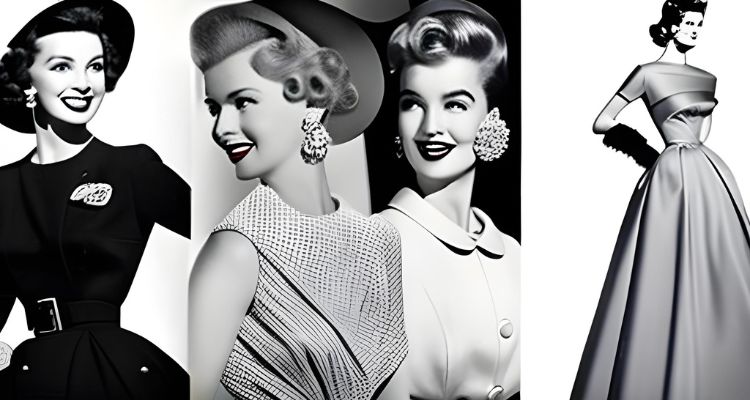It is commonly acknowledged that Fashion in 1954 was it’s most stylish and sophisticated ever. The year 1954 stands out as a particularly wonderful period of fashion among the years that marked this golden age. With designers and fashion icons influencing the globe with their cutting-edge creations and unique personal styles, the fashion industry was at its height. The era’s cultural and social norms, which included a heightened focus on femininity, glamour, and elegance, were mirrored in the fashion styles of the period. c The interaction at the time between the fashion business and society will also be examined, as well as the lasting impact.
I. Fashion Trends in 1954
1954 was a year of distinct fashion trends that showcased the elegance and sophistication of the era. The fashion industry was at its peak, and designers were creating iconic pieces that would influence fashion for years to come. One of the most significant trends of the time was the return of the hourglass silhouette, which accentuated the curves of the female form. This trend was embodied by the popular designs of Christian Dior’s “New Look,” which emphasized a nipped waist and full skirt. The hourglass silhouette was also achieved through the use of corsetry and foundation garments that provided a smooth and streamlined appearance.

Another popular trend in Fashion in 1954 was the use of luxurious fabrics such as silk, satin, and velvet. These fabrics added an air of glamour and sophistication to designs and were often used in evening wear and cocktail dresses. One of the most famous dresses of the era was the Marilyn Monroe “Happy Birthday Mr. President” dress, which was made from a sheer, flesh-colored fabric covered in over 2,500 rhinestones.
Bold patterns and colors were also prevalent in 1954 fashion trends. Polka dots, stripes, and checks were popular prints, while bold colors such as red, yellow, and blue were often used in daywear and accessories. The use of gloves and hats also remained popular in this era, adding an extra touch of sophistication to any outfit.
In summary, Fashion in 1954 reflected a desire for elegance, femininity, and glamour. The hourglass silhouette, luxurious fabrics, bold patterns and colors, and the use of accessories such as gloves and hats defined the iconic style of the era. These trends continue to inspire modern fashion designers and are remembered as a timeless example of the artistry and creativity of the fashion industry.
II. Key Fashion Designers of 1954
Fashion in 1954 was a year of exceptional creativity in the fashion industry, with many designers making significant contributions to the field. The following designers were among the most influential and notable of the era:
Christian Dior:
Christian Dior’s “New Look” revolutionized fashion in the 1950s. The iconic style emphasized a nipped waist, full skirt, and feminine curves, in contrast to the boxy, utilitarian styles of the wartime era. Dior’s designs were luxurious and romantic, featuring voluminous skirts, intricate beading, and elegant fabrics. His influence can still be seen in modern fashion, with designers often paying tribute to his iconic style.
Hubert de Givenchy:
A maestro of haute couture famed for his classy and sophisticated creations, Hubert de Givenchy. He was renowned for his use of pricey materials and elaborate embellishments like beading and embroidery. One of Givenchy’s most famous creations was the “Bettina Blouse,” which the model Bettina Graziani wore and had a high neck and a large bow.
Coco Chanel:
Coco Chanel was one of the most influential designers of the 20th century, known for her elegant and understated designs. Her iconic designs included the Chanel suit, which featured a collarless jacket and slim skirt, as well as the little black dress, which remains a staple in women’s wardrobes to this day. Chanel’s designs were characterized by their simplicity and elegance, and she is credited with popularizing the concept of “less is more” in fashion.
Balenciaga:
Construction expert Cristobal Balenciaga was renowned for his architectural creations. His designs were frequently sculptural and avant-garde, and he emphasized clear lines, straightforward forms, and sumptuous materials in his work. With designers frequently paying homage to his legendary creations, Balenciaga’s impact can still be evident in contemporary fashion.
In conclusion, the major fashion designers of 1954 were trailblazers who influenced the fashion business with their original ideas and creative views. Their contributions are remembered as evidence of the fashion industry’s enduring artistry and creativity and still have an impact on fashion today.
III. Influential Fashion Icons of 1954
The Fashion in 1954 were influential figures who inspired and defined the iconic style of the era. These women were trendsetters who represented the epitome of sophistication, glamour, and elegance. The following are some of the most influential fashion icons of 1954:
Audrey Hepburn:
One of the most well-known actresses of the 1950s and a key figure in that decade’s fashion was Audrey Hepburn. Her distinctive look was characterized by clean, uncomplicated lines and an emphasis on traditional elegance. Hepburn is remembered for her enduring black Givenchy dress from the film “Sabrina,” which stands as a model of class and refinement in attire.
Marilyn Monroe:
With her daring and dazzling style, Marilyn Monroe, a cultural icon, revolutionized fashion in the 1950s. She was renowned for having an eponymous hourglass shape, which she accentuated with form-fitting clothing and low necklines. Monroe’s fashion was distinguished by opulent materials, vivid hues, and unrestrained femininity.
Grace Kelly:
Hollywood actress Grace Kelly was also a major fashion influencer in the 1950s. Her look was distinguished by clear lines, straightforward shapes, and a focus on traditional elegance. Kelly’s legendary wedding gown, created by Helen Rose, is still regarded as a classic example of bridal attire due to its delicate lace accents and full skirt.
Elizabeth Taylor:
Elizabeth Taylor was a Hollywood star and a fashion icon of the 1950s. Her style was characterized by bold patterns, colorful fabrics, and an unabashed glamour. Taylor was known for her love of jewelry and often wore statement pieces to complement her outfits.
In summary, the influential fashion icons of 1954 were cultural figures who shaped the style and sophistication of the era. These women continue to inspire fashion today, and their enduring legacy is a testament to the enduring creativity and artistry of the fashion industry.
![]()
IV. Fashion Industry and Society in 1954
The fashion industry in 1954 was a vital part of society, reflecting the cultural and social changes of the era. The following are some of the ways in which the fashion industry and society intersected in 1954:
The rise of mass-produced fashion:
With the advent of mass-produced apparel in the post-war era, the fashion industry underwent considerable upheaval. Fashion became more inexpensive and available to a larger audience as a result of the advent of new production processes and the expansion of the synthetic fabric supply.
The influence of Hollywood:
In the 1950s, Hollywood had a big influence on what was fashionable. Millions of women were influenced by style idols like Audrey Hepburn, Marilyn Monroe, and Grace Kelly to copy their appearances. Fashion designers created attire that was influenced by the glitz and refinement of Hollywood as a response to this trend.
The impact of youth culture:
Teenagers began to have a greater impact on fashion trends in the 1950s, as youth culture became an important societal force. In response, the fashion industry created garments geared towards the young consumer, with designs like the poodle skirt, bobby socks, and saddle shoes becoming iconic icons of the time.
The influence of social and political change:
In the 1950s, there were significant social and political changes that affected fashion, including the civil rights movement and the expanding feminist movement. Women’s fashion and self-presentation changed as a result of the emergence of black models and designers and the growing emphasis on women’s empowerment in the workplace.
In conclusion, the fashion business and society in 1954 were closely related, with fashion serving as a reflection of the societal and cultural shifts taking place at the time. The emergence of mass-produced apparel, Hollywood’s influence, youth culture, and social and political transformation were all key influences that influenced fashion trends and contributed to the era’s defining style and sophistication.
V. Legacy of Fashion in 1954 Trends
Fashion in 1954 continue to have a lasting legacy, influencing fashion designers and inspiring fashion enthusiasts around the world. The following are some of the ways in which the legacy of 1954 fashion trends endures:
Timeless elegance and sophistication:
Clean lines, straightforward shapes, a concentration on classic designs, and timeless beauty and sophistication were the hallmarks of 1954’s fashion trends. With designers continuing to be inspired by the era’s famous styles, this aesthetic has maintained its popularity in the fashion industry.
The little black dress:
The little black dress, made known by Audrey Hepburn in the film “Sabrina,” is still a classic piece of clothing that is in style today. Numerous designers have reimagined the classic style, which is still a must-have item for women’s wardrobes everywhere.
The influence of Hollywood:
Hollywood continues to be a significant influence on fashion trends, with the styles of iconic actresses such as Audrey Hepburn, Marilyn Monroe, and Grace Kelly continuing to inspire designers and fashion enthusiasts alike.
The impact of youth culture:
Teenage Fashion in 1954 influenced trends and designs in the 1950s when youth culture had a significant impact on that sector of the economy. Youth culture continues to be a major influence on fashion today, with designers producing apparel that captures the distinct tastes and fashion preferences of younger generations.

VI. Conclusion
In summary, Fashion in 1954 was a turning point in style and elegance. Elegant and classic designs from that year have continued to influence fashion fans and designers for decades. Hollywood’s influence, the emergence of mass-produced clothing, the influence of youth culture, and the impact of social and political change were all key influences that impacted fashion trends and contributed to the creation of the era’s iconic style.
The legacy of 1954 fashion trends is a lasting aspect of the history of the fashion industry, influencing designers and fashion aficionados alike to this day, from the enduring appeal of the little black dress to the continuous impact of Hollywood on fashion. Overall, the timeless elegance and sophistication of 1954 fashion trends continue to captivate and inspire fashion lovers around the world, ensuring that the era will be remembered as a glorious period of style and sophistication in fashion history.

